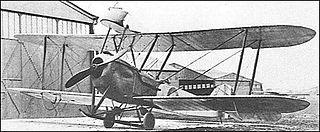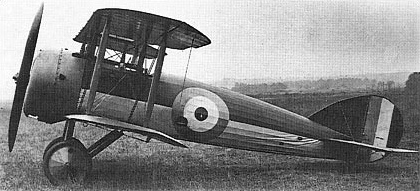
The Sopwith Camel was a British First World War single-seat biplane fighter aircraft that was introduced on the Western Front in 1917. It was developed by the Sopwith Aviation Company as a successor to the Sopwith Pup and became one of the best known fighter aircraft of the Great War.

The Sopwith TF.2 Salamander was a British ground-attack aircraft of the First World War designed by the Sopwith Aviation Company which first flew in April 1918. It was a single-engined, single-seat biplane, based on the Sopwith Snipe fighter, with an armoured forward fuselage to protect the pilot and fuel system from ground fire during low level operations. It was ordered in large numbers for the Royal Air Force but the war ended before the type could enter squadron service, although two were in France in October 1918.

The Vickers F.B.5 was a British two-seat pusher military biplane of the First World War. Armed with a single .303 in (7.7 mm) Lewis gun operated by the observer in the front of the nacelle, it was the first aircraft purpose-built for air-to-air combat to see service, making it the world's first operational fighter aircraft.

The Bristol Scout was a single-seat rotary-engined biplane originally designed as a racing aircraft. Like similar fast, light aircraft of the period it was used by the RNAS and the RFC as a "scout", or fast reconnaissance type. It was one of the first single-seaters to be used as a fighter aircraft, although it was not possible to fit it with an effective forward-firing armament until the first British-designed gun synchronizers became available later in 1916, by which time the Scout was obsolescent. Single-seat fighters continued to be called "scouts" in British usage into the early 1920s.

The Vickers F.B.19 was a British single-seat fighting scout of the First World War, developed from the Barnwell Bullet prototype, and sometimes known as the Vickers Bullet. It served with the Royal Flying Corps and the Imperial Russian Air Service, which subsequently led to the Red Air Force adopting it during the Russian Civil War.

The Armstrong Whitworth F.K.10 was a British two-seat quadruplane fighter aircraft built by Armstrong Whitworth during the First World War. While it was ordered in small numbers for the Royal Flying Corps and Royal Naval Air Service, it was not used operationally. It is one of the few quadruplane aircraft to reach production.

The Bristol M.1 Monoplane Scout was a British monoplane fighter of the First World War. It holds the distinction of being the only British monoplane fighter to reach production during the conflict.

The Vickers Type 143 or Bolivian Scout was a British single-seat fighter biplane designed and built by Vickers in 1929-1930. Six were built for Bolivia in 1930, which used the survivors in the Chaco War against Paraguay.

The Vickers Type 121 Wibault Scout was a British fighter built by Vickers in the 1920s. It was a licensed version of the French Wibault 7 aircraft, with 26 being sold to Chile in 1926, where they served until 1934.

The Vickers F.B.26 Vampire was a British single-seat pusher biplane fighter built by Vickers during the First World War.

The Vickers F.B.12 was a biplane pusher fighter aircraft developed during World War I by Vickers Limited. The failure of the engine for which it was designed, and the obsolescence of the pusher configuration, resulted in its remaining an experimental type only.

The Vickers Type 151 Jockey was an experimental low-wing monoplane interceptor fighter powered by a radial engine. It was later modified into the Type 171 Jockey II, which had a more powerful engine and detail improvements. Only one was built; it was lost before its development was complete, but the knowledge gained enabled Vickers to produce the more refined Venom.
The Sopwith 2FR.2 Bulldog was a prototype British two-seat fighter of the First World War. A single-engined biplane, the Bulldog was a fighter/reconnaissance aircraft intended to replace the Bristol F.2 Fighter, but was unsuccessful, with no replacement for the Bristol Fighter being purchased.

The Vickers F.B.11 was a prototype British three-seat escort fighter of the First World War. A large single-engined biplane, it carried one gunner in a nacelle mounted on the upper wing to give an allround field of fire. Only a single example was completed.

The Vickers E.F.B.7 was a prototype British fighter aircraft of the First World War. A twin-engined biplane, the E.F.B.7 was unsuccessful, only a single example being built.
The Vickers E.F.B.8 was a prototype British twin-engined fighter of the First World War. It was abandoned after only one aircraft was built, single-engined fighters being considered to have superior manoeuvrability.
The Sopwith 3F.2 Hippo was a prototype British two-seat fighter aircraft of the First World War. It was a single-engined biplane with considerable negative stagger. It was not successful, the Bristol F.2 Fighter being preferred by the Royal Flying Corps.

The Vickers F.B.16 was a British single-seat fighter aircraft of the First World War. It was originally designed to be powered by an experimental radial engine, development of which was abandoned. When re-engined with more powerful and reliable water-cooled V-8 engines, the F.B.16 demonstrated good performance, but only a few prototypes were built, the type not entering service.
The Vickers F.B.24 was a British two-seat fighter aircraft of the First World War. Only a few prototypes were built, as, although it had good performance, the Bristol F.2 Fighter was preferred.

Richard Harold Barnwell was an English aviation pioneer, who began as an aircraft builder. He died while flying an early Vickers fighter plane, as a test pilot.


















